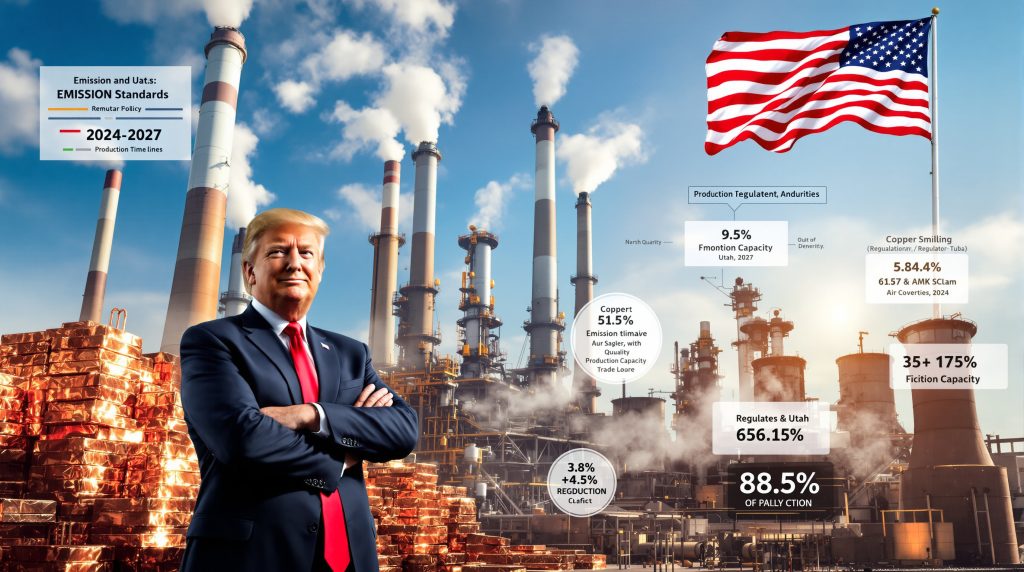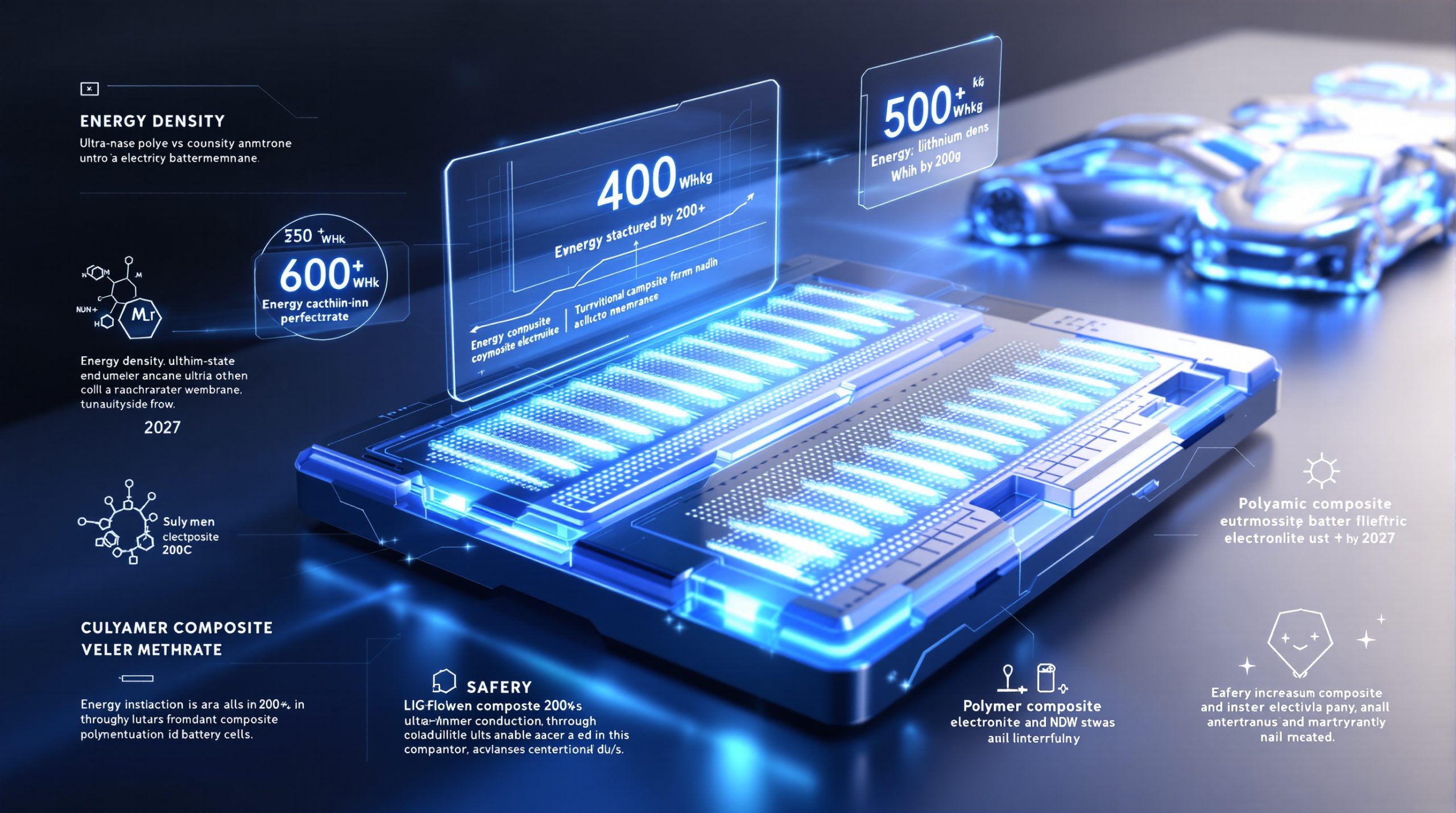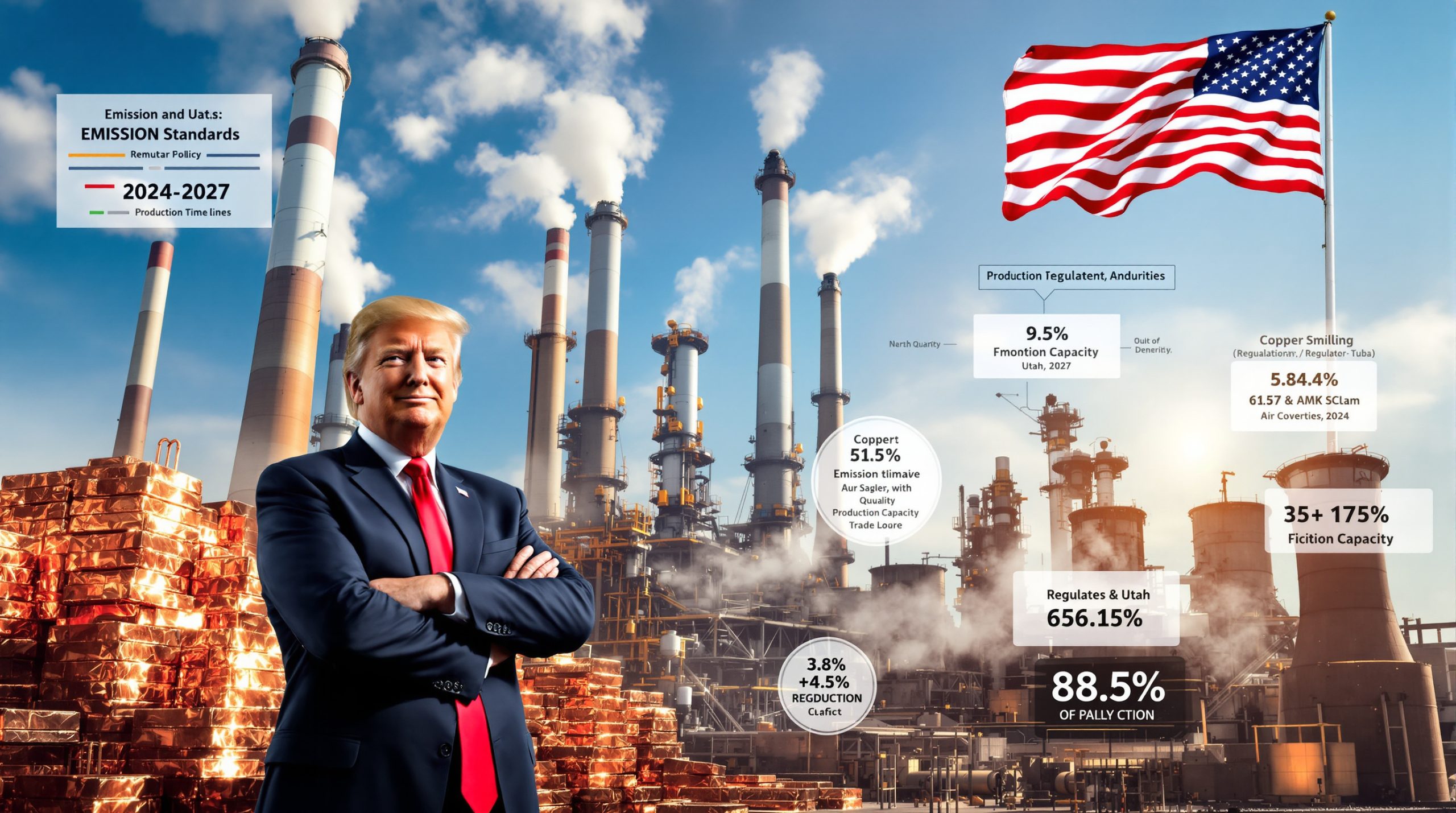Understanding Trump's Copper Smelter Policy Reversal
The Trump administration has implemented a significant policy shift affecting America's limited copper processing infrastructure. In October 2025, President Trump reversed environmental regulations that were finalised during the Biden administration in May 2024, granting domestic copper smelters a two-year exemption from stricter emission standards. This decisive action, part of the broader trump critical minerals order, marks a fundamental change in how the United States approaches industrial environmental compliance.
This regulatory rollback affects controls on multiple hazardous pollutants including lead, arsenic, mercury, benzene, and dioxins. The original Biden-era standards represented updated federal air quality requirements specifically targeting copper smelting operations across the United States.
The timing of this reversal reflects broader strategic considerations around mineral security and domestic industrial capacity. With only two operational copper smelters remaining in the entire United States, the administration positioned this decision as essential for maintaining America's processing capabilities during a period of heightened geopolitical tensions over critical mineral supplies.
Implementation Timeline and Scope
The regulatory exemption provides affected facilities with a 24-month compliance window from the October 2025 announcement date. This timeline creates a buffer period extending into 2027, during which smelting operations can continue without meeting the enhanced emission control requirements that were scheduled to take effect.
The scope encompasses what regulators classify as "affected stationary sources," which includes the specialised equipment and processes used in copper smelting operations. These facilities handle complex metallurgical processes that generate various airborne contaminants as byproducts of extracting pure copper from concentrated ores.
Furthermore, the exemption directly supports current copper investment insights by providing operational certainty for the two remaining domestic facilities. This regulatory relief coincides with industry expectations for continued strength in copper markets throughout 2025.
America's Limited Smelting Infrastructure
The United States operates just two copper smelters – one located in Arizona and another in Utah. This represents a dramatic reduction from the country's historical smelting capacity, highlighting the vulnerability of domestic copper processing capabilities.
Freeport-McMoRan (NYSE: FCX) and Rio Tinto (ASX: RIO) operate these remaining facilities, making them critical components of America's mineral processing infrastructure. The Utah facility is situated at the Bingham Canyon Mine site, one of the world's largest open-pit copper mines.
Strategic Importance of Domestic Processing
The concentration of copper smelting in just two facilities creates significant strategic vulnerabilities for the United States. Unlike many other countries that maintain multiple processing centres, America's limited capacity means that regulatory pressures or operational disruptions could severely impact domestic copper production.
Industry analysis reveals that these facilities represent the final remnants of what was once a more robust domestic smelting sector. The decline in U.S. copper processing capacity reflects broader trends in industrial consolidation and the migration of heavy manufacturing operations to regions with lower operational costs.
The current infrastructure serves multiple critical functions:
• Processing copper concentrates from domestic mining operations
• Refining imported copper materials for U.S. markets
• Supporting defence and infrastructure applications requiring domestically-sourced copper
• Maintaining technical expertise in complex metallurgical processes
National Security Justifications for Regulatory Relief
The Trump administration's decision stems from an executive order signed earlier in 2025 that designated copper as a critical material for defence, infrastructure, and emerging technologies. This classification encompasses applications in clean energy systems, electric vehicles, and advanced manufacturing processes.
The critical mineral designation triggered a Section 232 investigation to assess whether copper imports pose national security risks. This investigation focused specifically on America's dependence on a small number of foreign suppliers for processed copper products.
Trade Protection Measures
Following the Section 232 review, the administration implemented comprehensive trade protection measures that align with broader tariffs impact analysis on global supply chains:
• 50% tariff on certain imported copper products
• Mandatory domestic sales requirements for increasing percentages of high-quality U.S.-produced scrap copper
• Enhanced monitoring of foreign supply chain dependencies
These measures reflect concerns about supply chain vulnerabilities that could affect critical infrastructure, defence systems, and emerging technology sectors. The administration's position emphasises that maintaining domestic processing capability outweighs short-term environmental compliance costs.
Strategic Competition Considerations
The policy reversal occurs against a backdrop of intensifying global competition for critical mineral processing capacity. China dominates worldwide copper smelting operations, controlling significant portions of global refining capacity through both domestic facilities and overseas investments.
This concentration of processing power in foreign markets creates potential leverage points that could affect U.S. access to refined copper during periods of geopolitical tension. The administration's approach prioritises maintaining domestic alternatives to foreign-controlled processing networks.
Economic Implications of the Two-Year Exemption
The regulatory relief provides immediate economic benefits for the two remaining U.S. copper smelters by deferring substantial compliance costs. Environmental control equipment for managing lead, arsenic, mercury, benzene, and dioxin emissions typically requires significant capital investment and ongoing operational expenses.
Current copper price prediction models suggest continued strength at approximately $5.12 per pound (as of October 2025), supporting continued operation of domestic facilities. However, margin pressures from compliance costs could threaten long-term viability without this regulatory relief.
Investment Retention and Production Stability
The policy creates conditions for sustained investment in existing facilities rather than potential closure scenarios. Both Freeport-McMoRan and Rio Tinto can allocate resources toward operational efficiency improvements and capacity maintenance rather than compliance-related expenditures.
Production stability during the exemption period supports several key economic objectives:
• Maintaining employment at specialised metallurgical facilities
• Preserving technical expertise in copper smelting operations
• Supporting regional economies dependent on smelting operations
• Ensuring consistent domestic copper supply for manufacturing sectors
The exemption also provides time for industry participants to evaluate long-term technology investments that could achieve both environmental compliance and operational efficiency objectives.
Environmental Groups' Response to Regulatory Changes
Environmental advocacy organisations have expressed significant concerns about the health implications of relaxing emission standards for copper smelting operations. The affected pollutants – lead, arsenic, mercury, benzene, and dioxins – pose documented risks to human health and environmental quality.
According to Reuters reporting on the policy reversal, environmental groups argue that the exemption prioritises industry profits over community health. Communities surrounding copper smelting facilities face potential exposure to airborne contaminants that can accumulate in soil, water, and vegetation.
Public Health Monitoring Challenges
The two-year exemption period raises questions about ongoing air quality monitoring and health surveillance in affected communities. Environmental groups emphasise the importance of maintaining robust monitoring systems even during regulatory exemption periods.
Key concerns include:
• Baseline health data collection for future comparison studies
• Ambient air quality monitoring near smelting facilities
• Soil and water contamination assessment protocols
• Community notification systems for emission events
Public health advocates argue that regulatory exemptions should not eliminate transparency requirements or community right-to-know protections regarding facility emissions.
Technology Development During the Exemption Period
The two-year regulatory window creates opportunities for advancing cleaner smelting technologies without immediate compliance pressures. Industry participants can evaluate emerging emission control systems and potentially implement solutions that exceed original regulatory requirements.
Modern copper smelting facilities worldwide increasingly employ advanced pollution control technologies including:
• Electrostatic precipitators for particulate matter control
• Acid plant systems for sulfur dioxide capture and conversion
• Bag house filtration for fine particle removal
• Scrubbing systems for acid gas neutralisation
Research and Development Priorities
The exemption period provides time for collaborative research between industry, academic institutions, and technology vendors. Priority areas for development include integrated emission control systems that address multiple pollutants simultaneously while maintaining operational efficiency.
Innovation opportunities encompass both retrofitting existing facilities and developing next-generation smelting processes with inherently lower emission profiles. These advances could position U.S. facilities as global leaders in clean copper processing technology.
International Regulatory Comparison
Global copper smelting operations face varying environmental regulatory frameworks depending on their geographic location. European Union facilities operate under the Industrial Emissions Directive, which establishes comprehensive emission limits for heavy metals and organic compounds.
Chinese smelting operations follow standards established by the Ministry of Ecology and Environment, with enforcement varying by region and facility ownership structure. Canadian facilities must comply with federal and provincial environmental regulations that often exceed U.S. standards.
Competitive Position Analysis
The temporary regulatory relief affects the competitive positioning of U.S. smelters relative to international operations. Lower short-term compliance costs could improve profit margins, but may create longer-term challenges if global environmental standards continue tightening.
International copper buyers increasingly emphasise environmental, social, and governance (ESG) criteria when selecting suppliers. The exemption period provides time for U.S. facilities to develop comprehensive sustainability strategies that address both regulatory compliance and market expectations.
Market Response and Investment Implications
The policy announcement affects investor sentiment toward companies operating U.S. copper smelting facilities. Both Freeport-McMoRan and Rio Tinto benefit from reduced regulatory uncertainty and deferred compliance costs during the exemption period.
Market analysts view the regulatory relief as positive for near-term operational cash flows, though long-term environmental compliance requirements remain unchanged. The two-year window allows for strategic planning regarding technology investments and facility upgrades.
How Will This Affect Global Copper Supply?
The regulatory exemption directly supports current global copper supply forecast projections by ensuring continued operation of America's limited processing capacity. The two remaining facilities represent critical nodes in North American copper supply chains.
Companies can also allocate resources toward expanding their domestic mining operations to supply additional feedstock for the protected smelting capacity. This vertical integration approach could strengthen America's position in global copper markets.
Future Compliance Pathway and Industry Outlook
The 2027 compliance deadline creates a defined timeline for implementing environmental control technologies at both U.S. copper smelting facilities. Industry participants must balance continued operations with preparation for enhanced emission standards.
Technology vendors are likely to intensify marketing efforts toward U.S. smelters during the exemption period, offering integrated solutions that address multiple pollutant categories. The concentrated nature of the U.S. market – just two facilities – allows for customised approaches to environmental compliance.
Long-Term Strategic Planning
Beyond 2027, the U.S. copper smelting sector faces several strategic considerations:
• Technology modernisation requirements for sustained compliance
• Capacity expansion possibilities if domestic mining increases
• Export market development for processed copper products
• Workforce development for specialised metallurgical operations
The regulatory exemption provides breathing room for comprehensive strategic planning that addresses both environmental responsibility and industrial competitiveness.
Balancing Economic and Environmental Priorities
The Trump administration's reversal of Biden-era copper smelting regulations reflects fundamental tensions between environmental protection and industrial policy objectives. The decision prioritises short-term economic stability and national security considerations over immediate environmental compliance.
As detailed by CBS Austin, this approach acknowledges the strategic importance of maintaining domestic copper processing capabilities while deferring environmental compliance costs. The two-year exemption creates time for developing comprehensive solutions that address both economic and environmental concerns.
Policy Trade-offs and Implications
The regulatory reversal involves several key trade-offs:
• Economic benefits versus environmental costs
• National security priorities versus public health concerns
• Short-term relief versus long-term compliance requirements
• Domestic industry protection versus international competitiveness
These trade-offs reflect broader challenges in managing industrial policy during periods of geopolitical competition and supply chain vulnerability. The success of this approach will ultimately depend on whether the exemption period enables sustainable solutions that address multiple policy objectives simultaneously.
Disclaimer: This analysis is based on publicly available information and should not be considered as investment advice. Market conditions, regulatory requirements, and policy positions may change significantly during the exemption period. Readers should consult qualified professionals before making investment or business decisions related to copper smelting operations or related securities.
Want to Capitalise on Critical Mineral Policy Changes?
Discovery Alert's proprietary Discovery IQ model delivers real-time alerts on significant ASX mineral discoveries, including copper and other critical minerals, empowering subscribers to identify actionable opportunities ahead of broader market awareness of policy shifts like Trump's copper smelter exemptions. Begin your 30-day free trial today and secure your market-leading advantage in the evolving critical minerals landscape.




